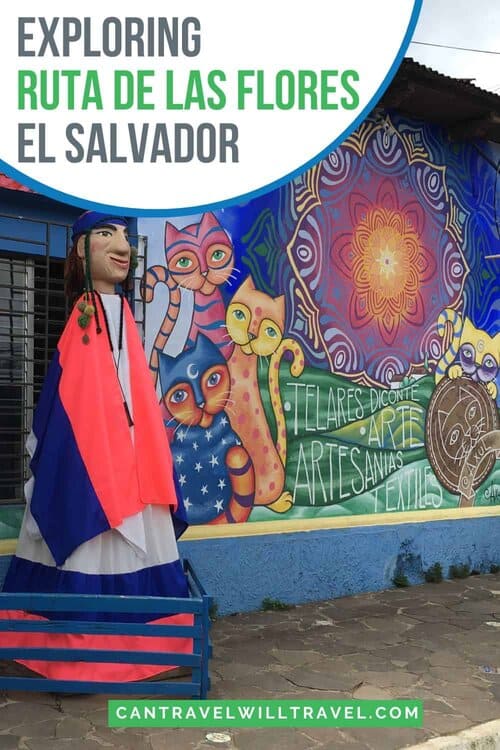Set in the highlands of western El Salvador, the Ruta de las Flores is a 36-kilometre stretch that offers travellers a blend of natural beauty, culture and culinary delights. Aptly named for the wildflowers that are scattered along its winding roads, this route connects six vibrant villages, each full of unique attractions and experiences.
Beyond its scenic landscapes, the Ruta de las Flores is ideal for visitors wanting to experience Salvadoran life. From Juayúa’s bustling food festivals to Ataco’s colourful murals, each village has something different to offer. Adventure seekers can soar through the treetops in Apaneca, while those who are interested in history and culture will enjoy Nahuizalco’s indigenous crafts.
During our time on El Salvador’s scenic flower route, we based ourselves in Juayúa and explored each of the surrounding villages. It gave us time to enjoy the different characters of each one, from sleepy backstreets to lively markets.
Based on our experience, I’ve pulled together everything you need to plan your Ruta de las Flores trip. Whether you’re a foodie, an adventurer, or just after a relaxing escape, this guide will help you make the most of your journey.
Affiliate Link Disclosure: This post contains affiliate links. If you use them to make a purchase, we may earn a small commission at no extra cost to you. As an Amazon Associate, we earn from qualifying purchases. Learn more in our Affiliate Link Disclosure.
Guide to Ruta de las Flores
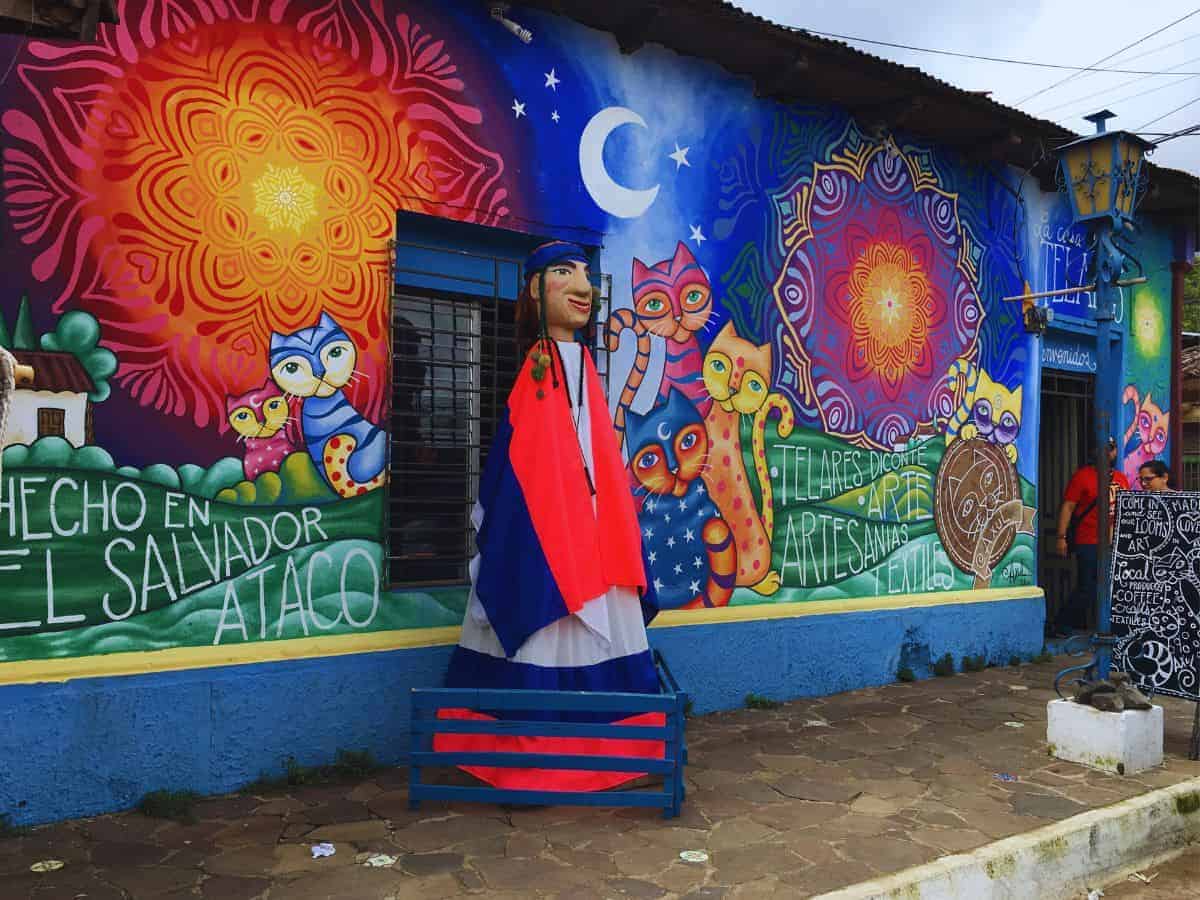
The Ruta de Las Flores isn’t just a scenic road. It’s a cultural journey through the western highlands of El Salvador, filled with food, art, and natural experiences. The road links six towns: Juayúa, Nahuizalco, Salcoatitán, Apaneca, Ataco, and Ahuachapán, each with its own identity.
You could technically drive it all in a single day, but it’s worth slowing down. Staying for three or four nights allows time to sample Juayúa’s Feria Gastronómica, wander Ataco’s mural-lined streets, hike Apaneca’s crater lakes, and explore Ahuachapán’s geothermal springs.
The route is at its best between November and February when wildflowers are in bloom and the waterfalls are flowing. Sadly, we went at the end of May, so we were too early to enjoy the flowers. Chicken buses run the route regularly, but car rental or private tours are also good options.
This guide introduces each town in turn, plus nearby activities, where to stay, and how to plan your trip so you can enjoy everything this corner of El Salvador has to offer.
Villages on the Ruta de las Flores
The six villages of the Ruta de Las Flores each offer a unique glimpse into Salvadoran life. Some are lively with food festivals and craft markets, while others are laid-back and artistic. Visiting all of them gives you the full picture, but if time is tight, you can choose a couple that best match your interests.
Here’s a closer look at each one, to help you decide which you’d like to add to your itinerary.
Juayúa

Juayúa is often considered the heart of the Ruta de Las Flores. Every Saturday and Sunday, the main square transforms into the Feria Gastronómica, a lively food festival where stalls sell everything from pupusas and tamales to grilled rabbit, and rum and pineapple cocktails. In January, the event expands into a week-long celebration with live music and artisan markets.
The town is also a hub for adventure. The Seven Waterfalls Hike is the standout activity, taking you through coffee plantations and forest trails to hidden cascades where you can swim. Guides are essential, both for safety and because the trails are unmarked.
Juayúa itself is charming, with cobbled streets, colonial-era buildings, murals, and small galleries. Its markets sell fresh produce and handicrafts, perfect for picking up souvenirs.
We stayed here for six nights and found it the best base for exploring the rest of the route. With friendly locals, great food, and easy transport connections, it’s both lively and welcoming.
Nahuizalco
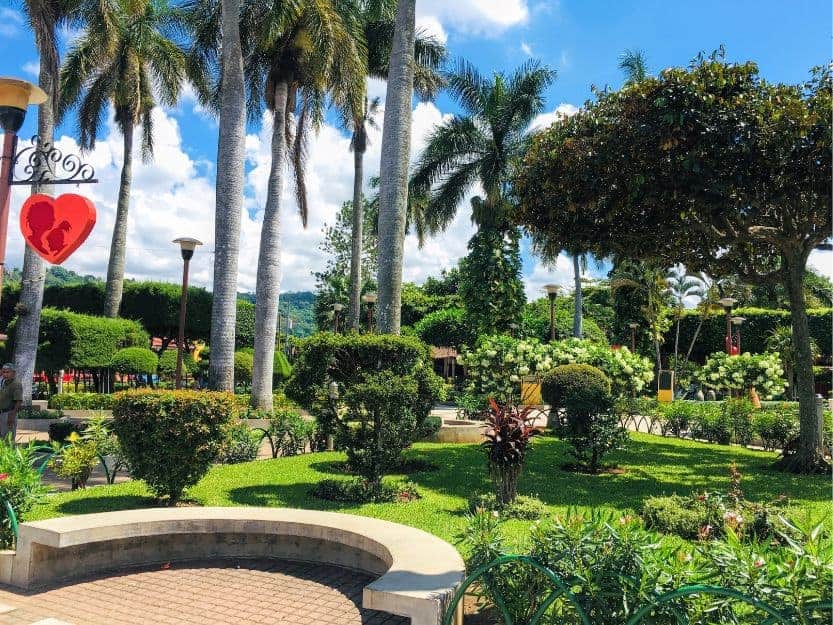
Nahuizalco has some of the deepest indigenous roots of any town along the Ruta de Las Flores. Known for its crafts and furniture-making traditions, it’s a place where artisan workshops still use traditional techniques to create baskets, woodwork, and textiles.
The highlight is the Saturday Night Market, when the town is lit by candles and filled with stalls selling street food and handmade goods. It has an intimate feel, and one of the most atmospheric experiences on the route.
During the day, you can watch artisans at work, explore murals that depict indigenous heritage, or visit the small museum near the pretty main square. If you’re a foodie, be sure to try atol de elote, a sweet, hot corn drink that is delicious.
Nahuizalco may be quieter than Juayúa or Ataco, but that’s part of its charm. It feels authentic and offers a glimpse into Salvadoran life that hasn’t changed much over time.
Salcoatitán
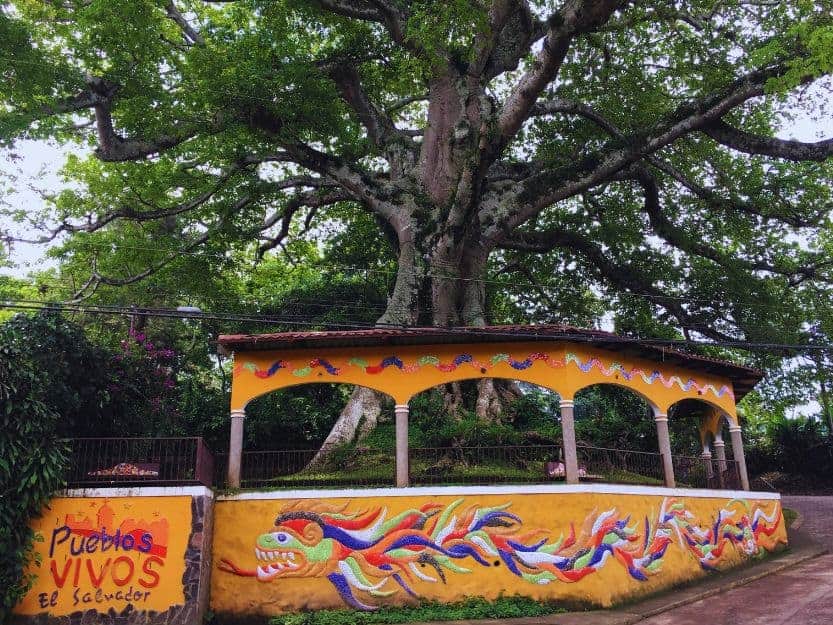
Salcoatitán is a smaller village, but it has a strong artistic identity. At its centre is a huge centenarian ceiba tree surrounded by colourful mosaics and murals of folklore and tradition.
The town is best known for its desserts. Sweet empanadas, filled with pumpkin or custard, are the local speciality. Washed down with a cup of freshly brewed highland coffee from a roadside café – this village will be a favourite for those with a sweet tooth.
The relaxed pace here makes it a lovely stop for those who want to slow down. Wander the central plaza, visit the local church, and take in views over the surrounding hills. While accommodation options are limited, Salcoatitán is worth a couple of hours as you move between larger towns.
Although often overlooked, its creativity and culinary treats made it one of our favourite stops on the route.
Apaneca
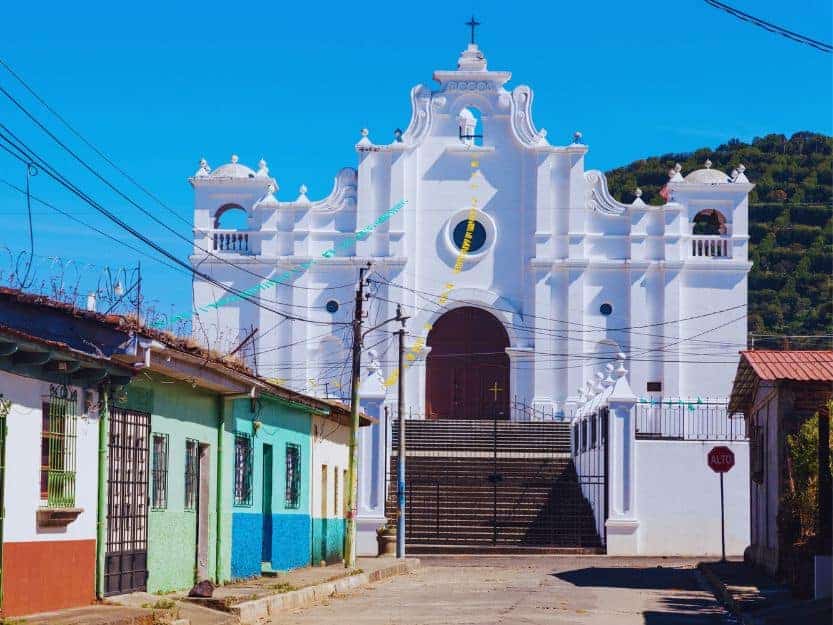
Apaneca sits at the highest point on the Ruta de Las Flores and is a playground for adventure seekers. The most popular attraction is Café Albania, an adventure park with zip-lines, a giant swing, and a massive bamboo maze. It’s a fun place to spend a day, with activities for adrealine junkies, or if you just want to try something new.
Nature lovers will enjoy the walk to Laguna Verde, a crater lake surrounded by forest. It’s peaceful and great for birdwatching, with trails that take you into the hills around the town.
Coffee is central to Apaneca, and you’ll find plenty of opportunities to take a tour of local plantations. Many are family-run, offering tastings and insights into how coffee is grown and roasted.
While the town itself is smaller and quieter than Juayúa or Ataco, the mix of outdoor adventures and coffee culture makes Apaneca a must-visit.
Concepción de Ataco
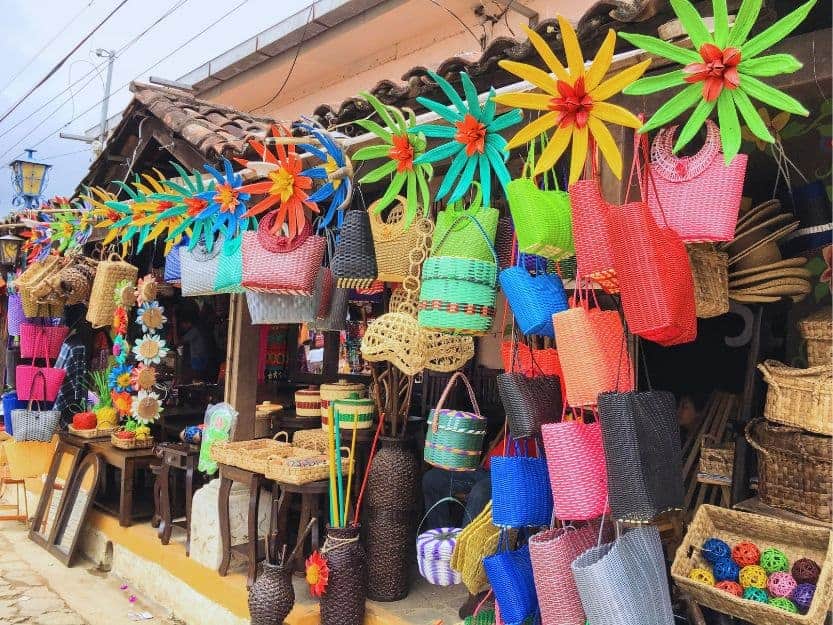
Ataco is one of the most colourful and arty towns in El Salvador. Almost every wall is covered in murals, with scenes that range from political messages to celebrations of daily life. Walking through Ataco feels like wandering an open-air gallery.
The town is also home to weaving cooperatives and artisan workshops where you can see textiles and ceramics being made. Shops sell high-quality crafts, making this a good place on the route to pick up souvenirs.
On weekends, there’s a smaller food fair in the central plaza, accompanied by music and a lively crowd. The cafés here are excellent too, many serving rich local coffee.
For a view, hike up to the Mirador de la Cruz, where you’ll find sweeping vistas over the town and the surrounding countryside.
Ahuachapán
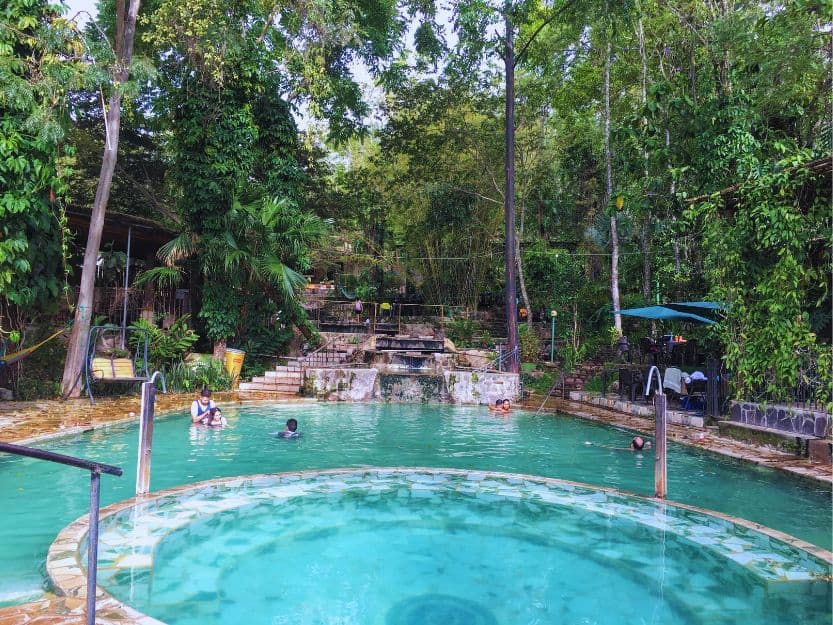
Ahuachapán is the largest town on the route and marks its western end. It’s best known for its geothermal activity. Steam vents rise from the ground, and nearb you’ll find the Termales de Santa Teresa. These are thermal pools surrounded by forest that make for a relaxing stop after days of exploring. We spent a very chilled couple of hours there one afternoon.
The town also has strong coffee tradition, and as mentioned already, plantation tours are a great way to learn more about El Salvador’s most famous export.
While Ahuachapán, again has a quieter pace compared to Juayúa or Ataco, it offers a fitting close to the Ruta de las Flores. Relax with a coffee, visit the thermal springs, and enjoy the slower rhythm before moving on.
Additional Activities Near Ruta de Las Flores
If you have more time, consider extending your trip to nearby Tacuba, just beyond Ahuachapán. This small town is the gateway to Parque Nacional El Imposible, one of El Salvador’s largest protected areas. Eco-lodges like Mama and Papas offer guided hikes that take you deep into the park, with trails leading to waterfalls, viewpoints, and diverse wildlife. Spending a night or two here allows you to enjoy the park fully.
Closer to Juayúa, the Los Chorros de la Calera waterfalls are a beautiful natural spot. They can be reached with a local guide and are ideal for a refreshing dip.
Where to Stay on Ruta de las Flores
Accommodation is spread across the villages on the Ruta de las Flores, but the most popular bases are Juayúa and Ataco.
In Juayúa, options range from budget guesthouses to comfortable mid-range hotels. Hostal Doña Mercedes is a great choice, with welcoming hosts, cosy rooms, a beautiful garden and breakfast included in the price. We loved our stay here, especially as it was so close to the weekend food festival.
In Ataco, you’ll find boutique hotels and artistic lodges, many decorated with local crafts. Staying in a converted hacienda is also possible, adding an authentic touch to your trip.
Apaneca has eco-lodges and smaller hotels, ideal if you want to spend your days hiking, zip-lining, or exploring crater lakes.
For a quieter stay, Salcoatitán has family-run guesthouses set among peaceful surroundings. Nahuizalco has fewer places to stay, but it is worth considering if you want an authentic local experience.
Wherever you choose, book in advance if you’re travelling over weekends or during festivals, as rooms fill quickly.
How to Get to Ruta de las Flores
Most people arrive on the Ruta de las Flores from San Salvador or Santa Ana and the journey is fairly straight forward. Centrocoasting has alot of useful information on getting to, from and around Ruta de las Flores, and Bookaway also offers lots of transport options which can be booked online.
By bus: Route 249 runs between Sonsonate and Ahuachapán, passing through most of the towns. Juayúa is slightly off the main road but well connected. Buses are frequent and cheap, though crowded at times.
By car: Renting a car offers flexibility and makes it easy to explore at your own pace. The roads are paved but winding, so allow extra time.
By tour: If you’re short on time, day trips run from San Salvador and Santa Ana. These tours usually include several of the towns, transport, and a guide.
Plan Your Trip to Ruta de las Flores
The Ruta de Las Flores is more than just a scenic road. It’s a celebration of Salvadoran life, with each village offering something unique. From Juayúa’s food festivals and Ataco’s murals to Apaneca’s adventure parks and Ahuachapán’s hot springs, the route packs a lot into a short distance.
For the best experience, spend three or four nights here. That gives enough time to enjoy several villages, take a hike, and slow down to the local rhythm. Visit between November and February if you want to see the wildflowers in bloom.
What are you most excited to experience on the Ruta de Las Flores? Tell us in the comments below.
Planning Your Trip to Ruta de las Flores?
Planning your trip to Ruta de las Flores in El Salvador? Here are some of our recommended useful resources to help you have the best time possible.
● TRAVEL INSURANCE IS AN IMPORTANT CONSIDERATION! World Nomads offers cover for travellers in over 100 countries and True Traveller is a great option if you’re from the UK or EU. SafetyWing is another solution, particularly for digital nomads and long-term travellers. ● Use Wise (formerly Transferwise) to send or receive money internationally. It’s cheap, easy and transparent. ● Find amazing flight deals on Skyscanner and Kayak. ● Compare rental car prices on Rentalcars.com. ● Booking.com and Expedia usually have the best hotel prices. ● Our go-to for self-catering accommodation is Vrbo. ● Discover fantastic trips and activities with Viator and GetYourGuide. ● Check out Bookmundi, G Adventures, and Intrepid Travel for group holidays and tours. |
Read More El Salvador9 Best Things to do in Playa El Tunco6 Reasons to Not Skip Lake Coatepeque |
Enjoy this post? Pin it for later!
